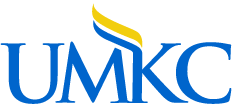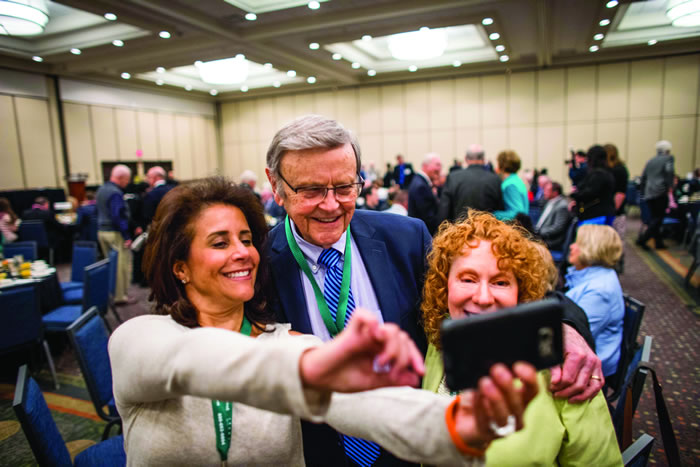Decades of dedication to their colleagues and professions come together every year
By Greg Hack
At the beginning of the 2019 Midwest Dental Conference, Dr. Rick Padley (DDS ’79) was obviously happy when he ran into his longtime friend and mentor, Dr. Hugh Bruner (DDS ’61).
“The weather was tough this winter,” Dr. Bruner said, “so we haven’t seen each other in a while. The conference always provides a good chance to see colleagues.”
Dr. Padley agreed: “We’ve kept close over the years, and we always have interesting, wide-ranging discussions. In fact, this is what the conference is all about — the relationships, personal and professional.”
Every year the Midwest Dental Conference, presented by the UMKC Dental and Dental Hygienists’ Alumni Associations, provides a forum for thousands of such meetings, where colleagues and classmates find fellowship and share their passion for the dental professions.
The conference also displays sweeping institutional scope, offering dozens of carefully planned continuing education lectures, class reunions and official business sessions. The 2019 conference drew more than 3,400 alumni and other dental professionals from 33 states.
And for nearly a century, the vast transfer of knowledge and renewal of relationships have made the Midwest Dental Conference a lasting and important part of the dental professions in the region and beyond.
How long has this been going on?
Though the Midwest Dental Conference name is a quarter-century old, a combination alumni-and-educational gathering in Kansas City dates back at least to 1923, when the Dental Alumni Association first met. Though no association records were preserved till after World War II, Dr. Leonard E. Carr did write many years later about his memories of the association’s second meeting in spring of 1924. That meeting, he said, was held in a 150-seat lecture room in the Kansas City-Western Dental College at 10th Street and Troost Avenue. Even then, besides commiserating and doing association business, the meeting had a serious educational component.
“There were three lectures that afternoon,” Dr. Carr wrote. “Believe me, I thought it was great to sit there and listen to those big men.”
Over the years the meetings grew and moved to downtown hotels such as the Muehlebach and then to Crown Center after it opened in 1971. The Dental Hygienists’ Alumni Association grew, too, and eventually synched its annual meeting and reunions with the Dental Alumni Association’s. The school’s 1992 annual report boasted: “An average of 2,800 alumni and students attend the annual alumni meeting each year, making it the largest gathering of its kind in the world.”
In the early 1990s, the conference was renamed. Some of its growth stemmed from its appeal to non-alumni dentists and dental hygienists in the region, who had come to know the value of its continuing education offerings.
In 1993, the conference was promoted as the Wild West Dental Roundup: A Midwest Dental Conference. And in 1994 it became simply the Midwest Dental Conference. Promotional materials touted its “69 total hours of continuing education credits” and said, “We’re pleased to open the doors of our highly successful annual convention to dental professionals from across the Midwest!”
Conferring great knowledge
Just as the materials used for restorations have evolved over the years, so have the conference’s educational offerings. The conference has increased both the number of continuing education credits available and the breadth of subjects covered. That has helped all members of dental practice teams keep up with breakthroughs, improvements and best practices — something attendees appreciate.
The 2019 amalgam of courses ranged from specialty sessions for periodontics, pediatric dentistry, prosthodontics, and oral and maxillofacial surgery to more general office- and business-management topics such as disaster preparedness and insurance coordination.
Dr. Alan Stoll (DDS ’82) said he regularly made the trip across Missouri from Hannibal, where he has practiced since 1986, to catch the conference’s specialty lecture in oral and maxillofacial surgery. Stoll said
Dr. Brett Ferguson (DDS ’81), chair of the school’s Department of Oral and Maxillofacial Surgery and Hospital Dentistry, and a past president of the American Association of Oral and Maxillofacial Surgeons, routinely lines up vital speakers.
“Many times I’ve incorporated what I learned in the talks. I take it right back to the office and start using it,” Dr. Stoll said. “The speakers are usually program directors and on the cutting edge of what’s being practiced. I love being able to listen and hear the latest.”
This year, Dr. Stoll heard Dr. Stuart Lieblich, DMD, a past president of the American Dental Society of Anesthesiology, speak on anesthesia issues for special patient populations.
Dr. Leiblich, who has had his own practice for decades and is
a clinical professor at the University of Connecticut, said, “I had a great time presenting at the Midwest Dental Conference. The conference offered a great variety of excellent programs, well thought out by the organizing committee.”
Like Dr. Stoll, Dr. Kelley Thompson (DDS ’94) makes it to the conference most years, especially for the lecture in her specialty, periodontics, which she practices in Prairie Village, Kansas.
Her classmate Dr. Lisa Thurlow (DDS ’94), who practices general dentistry with her husband in Overland Park, Kansas, said, “MDC consistently brings high-quality speakers who appeal to general dentists, specialists and team members.”
Dr. Thurlow is the clinical director for the dental hygiene program at a local career college and brings her students to the conference whenever possible.
“The conference generously allows students from any school to attend at no cost,” she said. “This is a great way for local students to see what an outstanding opportunity we have for CE in Kansas City after they graduate.”
A third classmate, Melanie Huckabee (DDS ’94), whose practice is in eastern Kansas City, Missouri, often brings her staff to the conference. Two popular 2019 sessions aimed at dental staffs, on customer service and office communication, were presented by Judy Kay Mausolf, an award-winning speaker. Her sessions were lively — and full.
“Everyone was so engaged and interested in learning, and so genuine,” Mausolf said. “I absolutely love the people I meet in the dental industry.”
Keeping memories alive —and making new ones
For all the history the Midwest Dental Conference holds and up-to-date knowledge it imparts, many attendees say it’s the relationships — with classmates, colleagues and mentors — that keep them coming back.
On Friday evening this year, at their 25th reunion event, Drs. Thompson, Thurlow and Huckabee were among the first to arrive, and grateful for a chance to catch up with one another on their practices, classmates and families. All three married other School of Dentistry alumni: Dr. Doug Thompson (DDS ’93), Dr. Todd Thurlow (DDS ’94) and Dr. Sam Huckabee (DDS ’95). And they were very involved with their class, Dr. Huckabee as class president and Dr. Thurlow as class secretary.
“Though we live in the area, we don’t get to see each other that often,” Huckabee said. Thompson finished the thought: “Because we’re so busy with our families and our practices. The conference is always a good chance to see each other.”
Dr. Thurlow said having a milestone reunion this year was especially nice, bringing together two-dozen classmates from states nearby and far away, from Arkansas and Oklahoma to Arizona and California. “We hadn’t seen some of them since dental school,” she said, “so that was great!”
The conference also has many offerings tailored for dental hygienists. Many alumni come every year to gain continuing education credits — and to see their classmates.
Kim Gillam and Mary Lu Day, both DH ’79, were back for their 40th reunion. “But we come almost every year anyway,” said Gillam, who has retired from practice but still drives in from Salina, Kansas. “Our class was really close — all 36 of us! We’d do anything for each other.”
The conference also helped them stay in touch over the years, and to pick up a year’s worth of continuing education credits in one weekend.
“And we had so much fun,” Day said. “We still do!”
Day, who lives in the Kansas City area, said, “It has been a perfect career for me, and the conference has always been something to look forward to. We love our profession, and it showed in the care we gave.”
Members of the DDS Class of 1969, back to celebrate their 50th reunion, echoed the hygienists’ dedication and camaraderie, and their sense that the school and their careers had given them the chance to live rewarding lives. Class members on Saturday — at breakfast, at dinner and at a hospitality suite in between — swapped stories about their school days and the profession they love.
Dr. Ronald Ingram practiced for many years in Pratt, Kansas, and still helps occasionally with free checkups at area schools. He keeps occupied now with a farm he bought near town, where he raises wheat, corn and milo. “It’s good pheasant hunting land, too,” said Dr. Ingram, who plays host to classmates each November during hunting season.
Like some of his classmates, he had another career before dental school, teaching junior high and coaching.
“I enjoy helping others, but I also was always curious and liked learning,” he said. “After dental school the conference was a regular part of that, allowing my practice to stay up to date. I’ve had a good ride.”
Dr. Dean Mason may, at age 91, be regarded as the dean of the class. “I came to dental school late, at age 39,” he said, after serving in the Pacific in World War II and then working for Boeing. “But I still had time to practice for a long time — 33 years in Wichita — and retire at age 75.”
If Dr. Mason is the dean of the class, Dr. Kenneth Cox is the ringleader. He has practiced for decades in the Kansas City area and always pulls together class events.
“I told them I wasn’t going to organize any more reunions, but they wouldn’t let me quit!” he said. “Seriously, it’s always great to see everyone. We’re all lucky men, happy for our dental education and the careers we’ve had. What else could we have done that would have helped people more? And most of us are still trying to help our communities and our younger dentists.”
Dr. Harry “Ed” Martin summed up what several of his classmates said: “Dental school was like going into battle together and living to tell the tale! We learned that if we worked hard, kept our mouths shut and helped each other, we’d make it. And we did.”
He continued: “The dental school was good to us, and we don’t forget that. It’s great to come back and see that so many of us are still around and doing well. I hope more recent graduates will support the school, too, and join the alumni association and keep it and the annual conference alive and thriving.”


